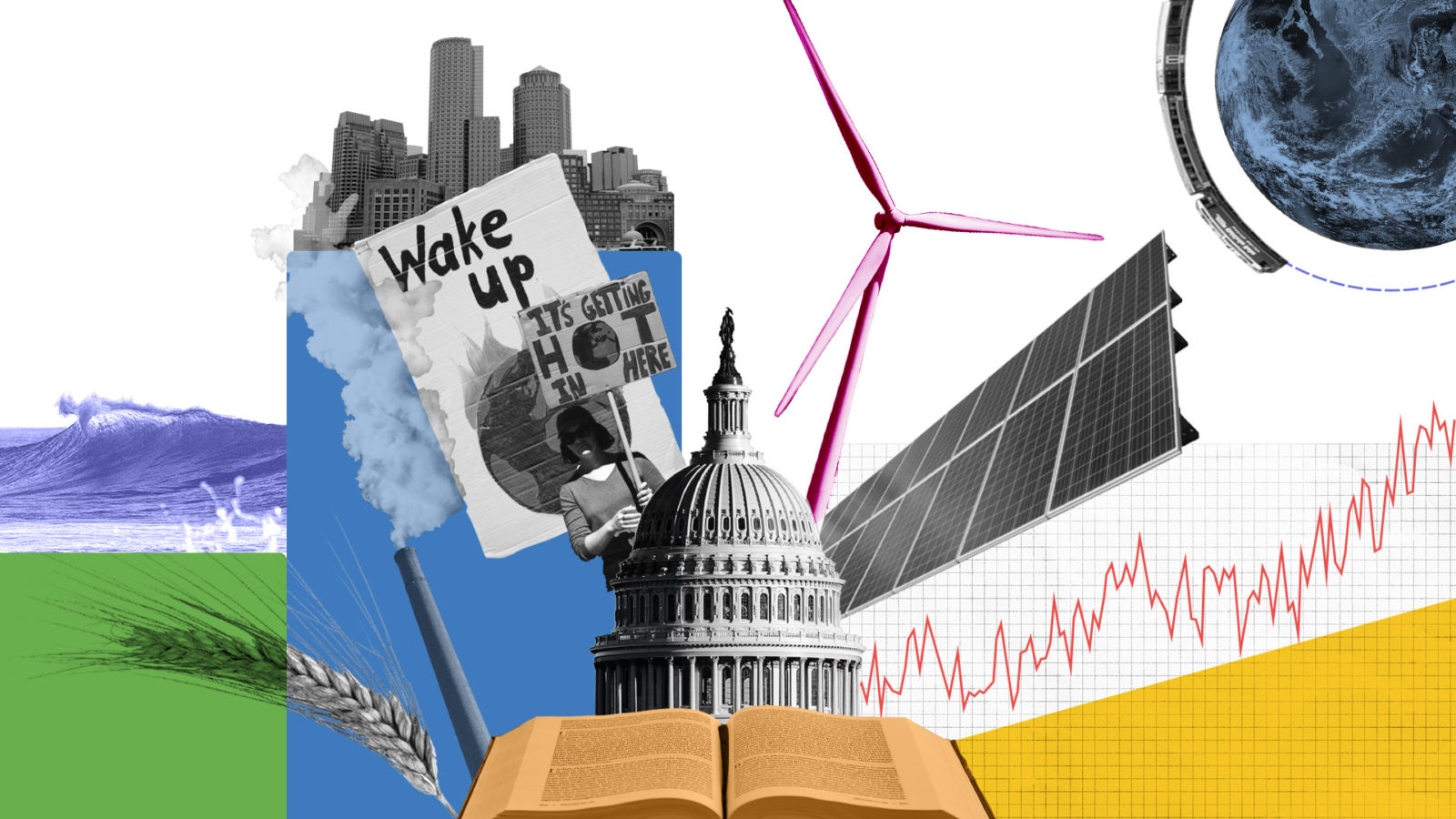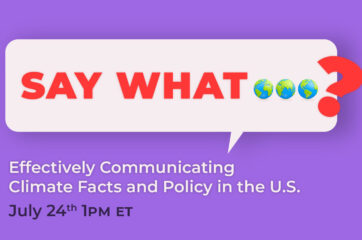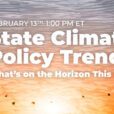This year, states were better positioned than ever to pass climate policies that reduce emissions and build resilience. States with strong records of passing climate policy continued to codify mitigation tactics, while the country’s largest-ever influx of federal funding enabled other states to pass more foundational legislation.
With state legislative sessions wrapping up across the country, we’ve summarized five major trends in climate policy we’ve tracked this year along with resources for taking further action.
1. Taking Advantage of New Sources of Climate Funding
Billions of dollars from the Infrastructure Investments and Jobs Act (IIJA) and Inflation Reduction Act (IRA) are already flowing to state and local governments, with much of this focused on climate programs. States can stretch these funds further, unlocking additional investment through mechanisms like green banks or other matching funds.
Resources:
- Climate Program Portal Outcomes Dashboard — Tracks funding awarded from climate programs in the Infrastructure Investments and Jobs Act and the Inflation Reduction Act.
- Green Banks and the IRA: How States Can Leverage Funding for Climate Action — Webinar from Climate XChange on how the IRA affects these financing institutions.
- Infrastructure Investment and Jobs Act & Inflation Reduction Act Tracker — This tool categorizes funding opportunities from IIJA and the IRA and provides application details, timelines, and links.
2023 State Examples:
- Massachusetts — Governor Healey announced the creation of the nation’s first green bank focused on making affordable housing more climate-friendly. The Massachusetts Community Climate Bank will receive $50 million in state funding, and will be eligible to receive federal financing from the IRA’s Greenhouse Gas Reduction Fund.
- Minnesota — The state passed legislation to create the Minnesota Climate Innovation Finance Authority, a green bank with the state contributing an initial $45 million in funding while expecting additional funds from the IRA.
- Minnesota — Governor Tim Walz signed HF 1656 into law, establishing the State Competitiveness Fund in the Minnesota Department of Commerce. The $115 million Fund provides grants for state agencies and local and Tribal governments to meet matching fund requirements for Infrastructure Investment and Jobs Act (IIJA) and the Inflation Reduction Act (IRA) funding opportunities. Other entities, including nonprofits, higher education institutions, and utilities, are also eligible for grant funding. The Department can also use funding to cover grant development and technical assistance costs.
- Wisconsin — Governor Evers signed Executive Order #195 on April 19th, creating the Green Ribbon Commission on Clean Energy and Environmental Innovation to advise on establishing the Green Innovation Fund, the state’s first green bank.
2. Putting the Brakes on Transportation Emissions
Transportation accounts for nearly a third of total U.S. greenhouse gas emissions, the most of any economic sector. Emissions from this sector increased slightly in 2022, with one analysis suggesting this was primarily due to an increase in air travel after many COVID-19 restrictions were lifted.
Still, technological advances and policy opportunities set the transportation sector up for a rapid reduction of greenhouse gas emissions from passenger and heavy transport vehicles, planes, and other mass transit options like trains and buses.
Resources:
- ACEEE State Transportation Electrification Scorecard — Evaluation of how states currently stand on their efforts to reduce transportation emissions.
- Understanding California’s Advanced Clean Truck Regulation — Part of RMI’s series to dive deeper into zero-emissions transportation requirements.
- State Climate Policy Dashboard, Transportation Hub — Learn about transportation policies and stay up to date on where they’ve been passed.
2023 State Examples:
- Advanced Clean Cars II — Massachusetts, New York, Oregon, Vermont, Virginia, and Washington adopted California’s Advanced Clean Cars II (ACC II) rules which came out last year. ACC II requires 100 percent of new car and light-duty truck in-state sales to be zero-emission vehicles by 2035. Delaware, Maine, Maryland, New Jersey, and Rhode Island started the process of adopting ACC II this year, with final regulations expected by the end of 2023.
- California —
- The U.S. EPA allowed California’s Advanced Clean Trucks (ACT) rule to move forward, which starting in 2024, requires an increasing percentage of truck sales to be zero-emission vehicles (ZEVs) through 2035. Under the ACT, by 2035, ZEVs will need to represent 55 percent of Class 2b-3 truck sales, 75 percent of Class 4-8 straight truck sales, and 40 percent of class 7-8 tractor sales. The rules have been adopted by Colorado, Massachusetts, New York, New Jersey, Oregon, Vermont, and Washington, , with Connecticut, Maine, Maryland, and Rhode Island planning to adopt them as well.
- The California Air Resources Board (CARB) approved the In-Use Locomotive Regulation, which targets emissions from trains when operating in the state. The rule sets a 30-minute idling limit in 2024, and bans in-state operation of locomotives older than 23 years old by 2030. Switch, industrial and passenger locomotives built in 2030 or after will be required to operate in zero-emissions configurations while in California, and in 2035 for freight lines.
- CARB also approved the Advanced Clean Fleets (ACF) rule to accelerate the transition to zero-emission trucks and buses. ACF establishes the first mandate to end the sale of combustion trucks by 2036, requiring an increasing percentage of zero-emission medium- and heavy-duty vehicle sales each year based on vehicle type, and requires that all fleets must be emissions-free by 2042. Find more information on the timeline for each vehicle type here.
- Colorado — Colorado adopted the Advanced Clean Trucks (ACT) and Low-Nitrogen Oxides (Low-NOx) rules to reduce heavy-duty transportation pollution in the state. The Low-NOx rule sets more stringent air pollution emissions standards for heavy-duty vehicles, beginning in model year 2027, and will reduce nitrogen oxide emissions for new vehicles by 90 percent compared to the current standard.
- Federal — The Biden administration proposed new rules to dramatically reduce pollution from cars and trucks. Announced on April 12th, they would require carmakers to cut pollution emitted from cars and pickups in 2032 to less than half of what they produce in 2026. The proposal does not include any electric vehicle (EV) sales requirements, however the EPA estimates EVs could make up 67 and 46 percent of new light- and medium-duty vehicle sales by model year 2032, respectively. The new rules would also establish more stringent standards to reduce greenhouse gas emissions from heavy-duty vehicles beginning in model year 2027 through 2032.
- Maryland — Governor Moore signed HB 0550, the Clean Transportation and Energy Act which extends the Electric Vehicle Recharging Equipment Program through fiscal year 2026 and increases funding from $1.8 million to $2.5 million annually. It also allows the Medium-Duty and Heavy-Duty Zero-Emission Vehicle Grant Program to cover up to 75 percent of vehicle costs, up from 20 percent established in the Clean Cars Act of 2022.
- Washington — Governor Inslee signed SB 5447, which requires the Department of Ecology to establish a pathway for sustainable aviation fuel in its Clean Fuels program, and provides tax incentives to encourage the production and use of these fuels.
3. Defining, Mapping, and Prioritizing Environmental Justice
Environmental justice (EJ) has increasingly become a priority for all levels of government, from local initiatives to state and federal programs. The Biden Administration’s Justice40 Initiative commits to directing 40 percent of certain clean energy benefits towards disadvantaged communities, and a number of states have begun to implement this standard.
It’s clear that adapting to climate change requires changing the fundamental systems our society is built on, which presents opportunities to reimagine how they can work for everyone. This year, states have made major progress on defining and mapping environmental justice communities and centering equity in their climate planning.
Resources:
- Council on Environmental Quality’s Climate & Economic Justice Screening Tool (CEJST)
- Put Your Money Where Your Mouth Is — Best Practices for Implementing Biden’s Justice40 Initiative — Climate XChange webinar on how states can build equity into their climate programs
- Lawyers for Good Government Disadvantaged Communities Report — Overview of various definitions and data available for identifying disadvantaged communities within each of the 50 states, Puerto Rico and Washington, D.C.
2023 State Examples:
- Delaware —The Delaware Department of Natural Resources and Environmental Control (DNREC) recently released its first version of an environmental justice mapping tool, called the EJ Area Viewer, which will be used to identify communities disproportionately impacted by environmental issues and inform future agency decisions.
- Maryland — Governor Moore signed HB0009, which requires that equity is incorporated into state transportation plans, goals, and reports. It also directs the Maryland Transit Administration to develop transit equity analysis policies and guidelines, which will be used to assess future transit projects.
- Minnesota — Governor Walz signed HF 7, which not only updates the state’s Renewable Portfolio Standard (RPS), but also codifies Minnesota’s definition of environmental justice communities. The law also prevents power produced by waste incineration in EJ communities from counting towards the 2040 RPS target. It also contains provisions that will help streamline the permitting process for new energy projects in the state, set minimum wage requirements for large-scale energy projects, and prioritize local job creation for those projects.
- New Jersey — New Jersey finalized regulations to implement the state’s landmark 2020 Environmental Justice Law aimed at reducing pollution in communities subjected to a disproportionately high number of environmental and public health stressors. The rules require enhanced upfront community engagement before pollution-generating facilities, such as landfills or gas-fired power plants, are proposed in overburdened communities. In addition, using the DEP’s new Environmental Justice Mapping, Assessment and Protection (EJMAP) tool, the EJ Rules direct permit applicants to avoid and minimize environmental and public health stressors and enable the DEP to establish permit conditions that better protect vulnerable communities.
- New York — New York released its finalized list of disadvantaged communities (DACs) throughout the state and a series of interactive maps that highlight the designated areas. State law requires that 35 percent of the benefits of clean energy and energy efficiency spending to meet the state’s climate targets are directed to DACs in the state.
- Washington — Governor Inslee signed HB 1181, which integrates climate change into the state’s planning framework and requires local governments to support greenhouse gas emission reduction goals, advance environmental justice, and foster resilience to climate impacts and natural hazards.
4. Strengthening Climate Targets and Drafting Plans to Meet Them
Setting strong, enforceable climate targets at the federal level will require legislation — a reality that seems unlikely at the present with an increasingly polarized Congress. Fortunately, at the state level, there is greater opportunity to set emissions goals that are aligned with science, while holding states accountable to meet them.
This year, states around the country have set new climate targets, strengthened existing ones, and developed plans to ensure they reach their goals.
Resources:
- State Climate Policy Dashboard, Climate Governance & Equity Hub — Learn about greenhouse gas emission targets and stay up to date on where they’ve been passed.
2023 State Examples:
- Colorado — Governor Polis signed SB23-016, which establishes new climate targets, requiring economy-wide emissions cuts of at least 65 percent by 2035, 75 percent by 2040, 90 percent by 2045, all below 2005 levels, and strengthens the state’s target to achieve net-zero greenhouse gas emissions by 2050. Colorado is the first state to legislate climate targets at regular intervals through 2050.
- Maryland — Governor Moore signed SB0781, known as the POWER Act. The legislation sets a nonbinding goal of 8.5 gigawatts of offshore wind capacity by 2031.
- Minnesota — Minnesota Governor Walz signed two significant bills this session: a bill that commits to 100 percent clean electricity by 2040, as well as an omnibus climate and environment bill (HF 2310), which codifies new climate targets, requiring the state to reduce greenhouse gas emissions 50 percent by 2030, relative to 2005 levels, and reach net-zero emissions by 2050.
- New Jersey — Governor Murphy signed Executive Order 315, which accelerates the state’s clean energy target from 2050 to 2035, requiring 100% clean electricity by 2035.
- New York — New York lawmakers finalized the state’s fiscal year 2024 budget, which includes major climate provisions to meet its statutory climate targets. The budget also sets the foundation for an economy-wide cap-and-invest program by creating a “New York climate action fund,” developed specifically to meet the state’s greenhouse gas targets. The Department of Environmental Conservation will release a draft program this year, with details including the declining emissions cap over time and the necessary guardrails to protect and benefit disadvantaged and low-income communities.
- North Carolina — The state released its Deep Decarbonization Pathways Analysis outlining short-, medium-, and long-term strategies to meet its 2030 and 2050 climate targets.
- Oregon — Oregon published the Oregon Climate Action Roadmap to 2030, which includes recommendations to meet the state’s goal of reducing emissions 45 percent below 1990 levels by 2035. The report also identifies additional policies to accelerate meeting the climate goal in 2030 instead.
5. Cutting Emissions from Buildings
There’s been a recent boom in building policies, with legislators introducing more than 1,000 policies across all states in this year alone. Between heating and electricity consumption, we use a lot of energy in our buildings, and it’s vital that in addition to switching to cleaner fuel sources, energy efficiency measures will make even dirty energy go further.
This year, states have been tackling building sector emissions both by prioritizing energy use in existing buildings while setting up new construction for success.
Resources:
- Energy Efficiency in a High Renewable Energy Future — This report from ACEEE explores the role that energy efficiency plays in decarbonizing the electricity system.
- Climate XChange Dashboard Digest Series — Read in-depth articles about buildings and energy efficiency policies featured on the State Climate Policy Dashboard.
2023 State Examples:
- Maryland — Governor Moore signed HB 0169, which establishes annual energy savings for low-income residential units, starting at 0.53 percent in 2024 and increasing to 1.0 percent in 2026.
- New York: The state became the first in the nation to pass a law banning natural gas hookups and other fossil fuels in most new buildings, requiring all-electric heating and cooking in new buildings under seven stories by 2026, and by 2029 for taller buildings.
- New Jersey — Governor Murphy signed Executive Order 316, which sets a building decarbonization goal of electrifying 400,000 homes and 20,000 commercial spaces by 2030, as well as making 10 percent of low-to-moderate income (LMI) residential units “electrification ready” by 2030.
- Vermont — Vermont enacted the “Affordable Heat Act” (S.5) into law after the legislature voted to override Governor Phil Scott’s veto. It establishes a clean heating standard, with declining carbon intensity of heating fuels over time. The Public Utilities Commission must adopt rules to implement the clean heat standard by January 2025.
What's Next?
This article includes a non-exhaustive list of major climate policy updates from states in 2023. As June comes to a close, most state legislative sessions have ended or are wrapping up soon. Sign up for our newsletter to stay up-to-date on the latest policy progress!









